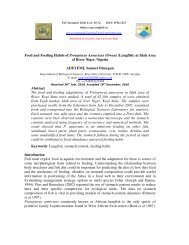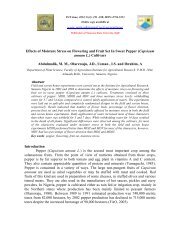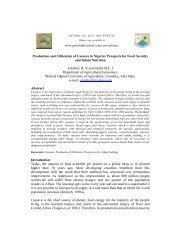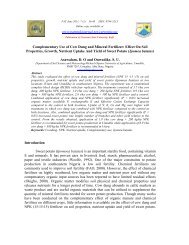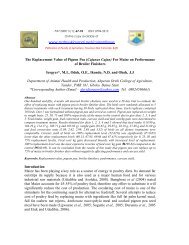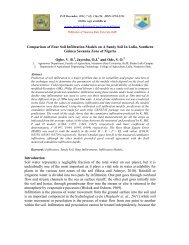View Publication - Production Agriculture and Technology Journal
View Publication - Production Agriculture and Technology Journal
View Publication - Production Agriculture and Technology Journal
Create successful ePaper yourself
Turn your PDF publications into a flip-book with our unique Google optimized e-Paper software.
PAT December, 2012; 8 (2): 100-116 ISSN: 0794-5213<br />
Online copy available at<br />
www.patnsukjournal.net/currentissue<br />
<strong>Publication</strong> of Nasarawa State University, Keffi<br />
Determinants of Rice Marketable Surplus In Yala Local Government Area of<br />
Cross River State, Nigeria<br />
Tiku N. E. <strong>and</strong> G. Ugbada<br />
Department of Agricultural Economics <strong>and</strong> Extension, Cross River University of <strong>Technology</strong>, Obubra Campus<br />
ejortiku@gmail. Com +2348035859130<br />
Abstract<br />
The study examined the determinants of rice marketable surplus in Yala Local Government<br />
Area of Cross River State. R<strong>and</strong>om sampling produce was use to select 120 rice farmers <strong>and</strong> a<br />
structured questionnaire was used. The basic objective was to determined factors that affect<br />
the quantity of rice supplied to the market after production from the farm. Both socio <strong>and</strong><br />
economic elements were considered. The simple descriptive statistics <strong>and</strong> multiple regression<br />
analysis were used as the analytical tools. Results show that variables such as quantity of rice<br />
for gift, quantity of rice consumed, quantity of rice reserve for seed, quantity reserve for<br />
uncertainty, level of education, house-hold size, quantity of rice produced, cost of<br />
transportation, <strong>and</strong> cost of production as well as farmers socio-economic characteristics<br />
positively influenced the quantity of rice sold in the area. The study recommended that rice<br />
producers in the study area should increase their hectare of rice cultivation as well as apply<br />
all the necessary agronomic practices as these will increase the marketable surpluses. Also,<br />
Local varieties of rice should be replaced with improved varieties to enhance high yield.<br />
Farmers should be encouraged by the government through giving them loans, subsidies <strong>and</strong><br />
Agro-chemicals like fertilizer <strong>and</strong> herbicide at affordable prices to reduce cost of production<br />
<strong>and</strong> to increase commercial quantity of rice in the market.<br />
Key words: Determinants, Rice marketable surplus, Subsidies, Rice production.<br />
Introduction<br />
Rice is one of the most common <strong>and</strong> important grain consumed in almost every household<br />
today in Nigeria. Despite its importance, the marketable surplus has not been able<br />
to meet up with the increasing dem<strong>and</strong> as a result of the increasing population. In<br />
agriculture as a whole, marketing surplus plays a very vital role in determining the<br />
amount of rice produce that are available in the market for sales Garth et al (2006).<br />
Bamidele et al (2010) reported that due to the contribution of rice to the per capita<br />
calorie consumption of Nigerians, the dem<strong>and</strong> for rice has been increasing at a much<br />
faster rate than domestic production. It was also reported that the output of local rice<br />
was estimated to be three million tones, while the dem<strong>and</strong> amounted to five million<br />
tonnes (Rahji <strong>and</strong> Adewumi, 2008).
PAT 2012; 8 (2): 101-116 ISSN: 0794-5213; Tiku <strong>and</strong> Ugbada; Determinants of Rice Marketable Surplus ….… 102<br />
As a measure to bridge the gap between supply <strong>and</strong> dem<strong>and</strong> for rice in Nigeria, the<br />
government intervened in the rice sector by increasing import tariffs so that local<br />
production could be encouraged (Bamidele et al, 2010).<br />
In 2000, Rahji et al (2008) reported that out of about 25 million hectares of l<strong>and</strong><br />
cultivated to various food crops, only about 6.37% was cultivated to rice. During this<br />
period, the average national yield was 1.47 tonnes per hectare. Generally, the price of<br />
rice determines the availability of the marketable surplus in the market. This is because<br />
the interest of every farmer is to be able to make sufficient profit from the sales of what<br />
they produce, supply <strong>and</strong> market.<br />
Self sufficiency in rice production <strong>and</strong> marketing can also be feasible only if there is an<br />
improvement in production techniques <strong>and</strong> also if the rural rice farmers are assisted to<br />
reduce the cost of production. The importation of rice into Nigeria from the world<br />
market annually is over three hundred million US dollars (Ak<strong>and</strong>e, 2002). If this trend<br />
continues, the supply of rice would not be able to meet up the increasing dem<strong>and</strong>. The<br />
study is of paramount importance as it examines the factors that influence the<br />
availability of commercial quantity of rice in Yala Local Government Area of Cross<br />
River State.<br />
Theoretical Framework<br />
Marketable surplus in the agricultural sector contribute to capital formation in the nonagricultural<br />
sector, improvement of st<strong>and</strong>ard of living in the sector by making available<br />
industrial consumer goods <strong>and</strong> capital formation in the sector by fetching the requisites<br />
of agricultural production ( Awotide <strong>and</strong> Adejobi, 2004). They also noted that every<br />
agricultural commodity is either produced for subsistence (home consumption) or for<br />
sale in the market to earn some cash income <strong>and</strong> thereby meet family requirement<br />
which are not satisfied on the farm income.<br />
Marketable surplus is the residual production of agricultural produce left with the<br />
producer after meeting his requirements of family consumption, farm needs (seed <strong>and</strong><br />
feed), kind payments <strong>and</strong> quantity added to end- of year stocks( Awotide <strong>and</strong> Adejobi,<br />
2004). An average Nigerian farmer cultivates rice using family labour on small<br />
fragmented l<strong>and</strong> holdings to produce a little surplus or sell to earn cash income to meet<br />
other family needs. The agricultural sector in Nigeria is characterized by subsistence<br />
farmers whose output levels are not enough to meet the dem<strong>and</strong> (Alteri <strong>and</strong> Bisari,<br />
2003). Chinin (1976) noted that marketable surplus is the commercial quantity of rice in<br />
the market.<br />
This means that total rice output for a given year (QOUT) can be disposed off in several<br />
ways. It can be sold for cash in the free market (QSOLD), bartered for house
PAT 2012; 8 (2): 101-116 ISSN: 0794-5213; Tiku <strong>and</strong> Ugbada; Determinants of Rice Marketable Surplus ….… 103<br />
consumption item (HOUSKD), used to pay in kind farm household (QCONS), or added<br />
to end of year stocks (STOCKS).<br />
There is paucity of information on rice marketing surpluses due to less attention paid to<br />
the concept. There is therefore need to provide vital information that will give scholars<br />
<strong>and</strong> the stake holders a better underst<strong>and</strong>ing on the actual relationship between the<br />
quantities of rice produced <strong>and</strong> the quantity that actually reach the market for sale.<br />
Therefore, the broad objective of this study is to analyze the factors affecting the<br />
availability of rice marketing surpluses in Yala Local Government Area. The specific<br />
objectives are:<br />
1. to estimate the average quantity of rice produced;<br />
2. determine the quantity of rice sold by farmers;<br />
3. estimate the factors that affect the degree of variation of rice produced <strong>and</strong> rice<br />
sold.<br />
Research Methodology<br />
Study Area<br />
This research work was conducted in Yala Local Government Area of Cross River<br />
State. Yala is located in the Nothern Sanatorial District of Cross River State <strong>and</strong> it is<br />
bounded in the North by Benue State, in the South by Ikom <strong>and</strong> Obubra Local<br />
Government Areas of Cross River State, in the East by Bekwara <strong>and</strong> Ogoja local<br />
Government Areas <strong>and</strong> in the West by Ebonyi State (Ogonu, 2010). Yala lies within<br />
latitude 6 O 50N <strong>and</strong> longitude 8 0 50E of the equator. It has a total l<strong>and</strong> area of 1,739km 2<br />
<strong>and</strong> a population of 210,843 (Ogonu, 2010). The climate is characterized by distinct wet<br />
<strong>and</strong> dry seasons. The temperature is fairly uniform with a mean monthly average of<br />
about 27 0 C.The major economic activities in the area are agriculture, fishing, mining<br />
<strong>and</strong> trading. The major foods crops produce are rice, yam, cassava, <strong>and</strong> maize.<br />
Sampling Techniques<br />
A multi- stage sampling techniques was used; the first stage is the identification of the<br />
council wards in Yala Local Government Area. The second stage is the selection of four<br />
villages each in each of the council wards. The third stage is the r<strong>and</strong>om selection of<br />
three rice farmers from each of the four villages. While the fourth stage is the<br />
administration of questionnaires to twelve rice farmers in each of the council wards,<br />
given a total of 168 rice farmers that was used to generate data for the study.<br />
Analytical Techniques<br />
Multiple Regression analyses was used to find the relationship between the dependent<br />
variable (quantity sold) <strong>and</strong> the independent variables, of farm size, household size,<br />
distance to the processing site, quantity of rice for gift, age of the farmer, level of
PAT 2012; 8 (2): 101-116 ISSN: 0794-5213; Tiku <strong>and</strong> Ugbada; Determinants of Rice Marketable Surplus ….… 104<br />
education, quantity of rice consumed, cost of transportation, total cost of production,<br />
farming experience, quantity reserve for uncertainty, quantity use to settle debts,<br />
quantity reserve for seed, sex, distance to the farm <strong>and</strong> quantity produced. The general<br />
expression is given as<br />
Y=(X 1 ,X 2 ,X 3 ,X 4 X 16 ) (1)<br />
While, the regression model is specified as<br />
Qs=b o +b 1 X 1 +b 2 X 2 +b 3 X 3 +b 4 X 4 +b 5 X 5 +b 6 X 6 +b 7 X 7 +b 8 X 8 +b 9 x 9 +b 10 X 10 +b 11 X 11 +<br />
b 12 X 12 +b 13 X 13 +b 14 X 14 +b 15 X 15 +b 16 X 16 +e(2)<br />
Where:<br />
Qs= quantity of rice sold (N);<br />
X 1 = size of the farm (ha);<br />
X 2 = distance to the farm (Km);<br />
X 3 = distance to the processing site (Km);<br />
X 4 = quantity of rice for gift;<br />
X 5 = age of the farmer (years);<br />
X 6 = quantity of rice use to settle debts;<br />
X 7 = quantity of rice consumed;<br />
X 8 = quantity rice reserve for seed;<br />
X 9 = quantity reserve for uncertainty;<br />
X 10 = sex<br />
X 11 = educational level (years);<br />
X 12 = household size;<br />
X 13 = farming experience (years);<br />
X 14 = quantity produced (Kg);<br />
X 15 = cost of transportation (N);<br />
X 16 = cost of production (N);<br />
b o = intercept;<br />
b 1 -b 16 = co-efficients <strong>and</strong><br />
e = error term.<br />
The above equation was subjected to multiple regression analysis using three functional<br />
models such as linear, semi-log, <strong>and</strong> double log functional forms. The forms of the<br />
equation are as follows;<br />
1. Linear:<br />
Qs=b o +b 1 X 1 +b 2 X 2 +b 3 X 3 +b 4 X 4 +b 5 X 5 +b 6 X 6 +b 7 X 7 +b 8 X 8 +b 9 x 9 +b 10 X 10 +b 11 X 11 +<br />
12+b 13 X 13 +b 14 X 14 +b 15 X 15 +b 16 X 16 +e<br />
.(3)
PAT 2012; 8 (2): 101-116 ISSN: 0794-5213; Tiku <strong>and</strong> Ugbada; Determinants of Rice Marketable Surplus ….… 105<br />
2. Semi-log: Qs= logb o + b 1 log X 1 + b 2 log X 2 + b 3 logX 3 + b 4 log X 4 + b 5 log X 5 + b 6<br />
logX 6 + b 7 logX 7 + b 8 log X 8 + b 9 logx 9 +b 10 log X 10 + b 11 logX 11 + b 12 logX 12 +<br />
b 13 logX 13 + b 14 logX 14 + b 15 logX 15 + b 16<br />
logX 16 +e............(4)<br />
3. Double log (Cobb-Douglas): Qs= logb o + b 1 log X 1 + b 2 log X 2 + b 3 logX 3 +<br />
b 4 log X 4 + b 5 log X 5 + b 6 logX 6 + b 7 logX 7 + b 8 log X 8 + b 9 logx 9 +b 10 log X 10 + b 11<br />
logX 11 + b 12 logX 12 + b 13 logX 13 + b 14 logX 14 + b 15 logX 15 + b 16<br />
logX 16 +e..(5)<br />
Results <strong>and</strong> Discussions<br />
This section presents, analyzed <strong>and</strong> discusses the data generated from the field on socioeconomic<br />
characteristics of the respondents <strong>and</strong> the output of the regression results.<br />
From table 1 below, the total number of respondents sampled for the study were 168 out<br />
of this 85.71% were male ,while the females were represented by 14.29%. This shows<br />
that rice cultivation in Yala Local Government Area is not gender exclusive because<br />
both male <strong>and</strong> female cultivated rice. However, the female farmers are fewer in number<br />
as compare to their male counterpart. This is so because male have more asses to<br />
swamp l<strong>and</strong> <strong>and</strong> other economic inputs than female in the study area. Also, the rice<br />
produced in the household is controlled by men. Women assist their husb<strong>and</strong>s in the<br />
cultivation, processing <strong>and</strong> marketing the products.<br />
Source: Field survey 2011.<br />
Figure 1: Showing distribution of respondents by sex.
PAT 2012; 8 (2): 101-116 ISSN: 0794-5213; Tiku <strong>and</strong> Ugbada; Determinants of Rice Marketable Surplus ….… 106<br />
Figure 1 is a reflection of the sex distribution of the respondent among rice farmers in<br />
the study area. From figure 1 above, male rice farmers are 144, while their female<br />
counterparts are 24, giving a total of 168 rice farmers was used for the study in the area.<br />
Table 1 also, indicates that 77.4% of the farmers in the area are married, while 22.61%<br />
are unmarried. The implication is that rice production in the area is mostly carried out<br />
by married men/women. This is likely so because of the requirement needed to cultivate<br />
rice in the study area, as most unmarried are young <strong>and</strong> are in school, or doing other<br />
businesses other than farming.<br />
Figure 2: Distribution of Respondents by Marital Status<br />
The pie chart in figure 2 above reveals that married men/women has a population of<br />
130, while unmarried made up the remaining 38, giving a total of 168 rice farmers. The<br />
pie chart also shows that rice cultivation is mostly carried out by married men/women<br />
than those who are single. This is because the amount of labour required cultivation is<br />
high <strong>and</strong> the total cost of production is also high <strong>and</strong> involves a lot of capital.<br />
Table 1: shows the age grouping of the respondents. It indicates that 44.0% of the<br />
respondents fell within 30-39 years. This implies that rice production in the area is<br />
predominantly carried out by people within this age bracket in the study area; rice<br />
production is done by active <strong>and</strong> energetic people in their middle ages. However, few<br />
old people (8.4%) also cultivate rice in the area as this is represented by the age bracket<br />
of 50 years <strong>and</strong> above. This can be seen in figure 3
PAT 2012; 8 (2): 101-116 ISSN: 0794-5213; Tiku <strong>and</strong> Ugbada; Determinants of Rice Marketable Surplus ….… 107<br />
Figure 3: Distribution of Respondents by Age<br />
The educational level of respondents in table 1, shows that 20.2% of rice farmers in the<br />
area are not educated while about 79.8% had some forms of formal education.<br />
Figure 4: Distribution of Respondents by Level of Education<br />
Table 1: below shows that the household size of 6-10 persons had 47.0%, had the<br />
highest frequency, which mean that rice cultivation needs average family labour to<br />
assist in the venture because it is labour intensive technology that is prevalent in the<br />
study area <strong>and</strong> increase family size guarantee labour availability.
PAT 2012; 8 (2): 101-116 ISSN: 0794-5213; Tiku <strong>and</strong> Ugbada; Determinants of Rice Marketable Surplus ….… 108<br />
Source: Field survey 2011<br />
Figure 5: Distribution of Household size of the Respondent<br />
The figure 5 indicates that household size of 6-10 members has 79% from the pie chart,<br />
The pie chart shows that those with household sizes of 6-10 members contribute more<br />
to rice marketable surplus in the study area.<br />
Table 1 below also, illustrated that 51.79% of the farmers had farming<br />
experience of between 16 years <strong>and</strong> above, 22.02% This implies that rice farming is not<br />
only an occupation but a way of life of the people in the study area.<br />
10<br />
87<br />
34<br />
37<br />
1-5 years<br />
6-10 years<br />
11-15 years<br />
16 <strong>and</strong> above<br />
Figure 6: Distribution of Respondents Farming Experience
PAT 2012; 8 (2): 101-116 ISSN: 0794-5213; Tiku <strong>and</strong> Ugbada; Determinants of Rice Marketable Surplus ….… 109<br />
The pie chart in figure 6 above reveals that rice farmers that fall within the bracket of<br />
16 years <strong>and</strong> above occupies the highest percentage of 87%, they constitute the section<br />
of the respondents that contribute more rice to the market.<br />
Table 7: shows the mode of transportation of rice farmers in the area. 54.2% of farmers<br />
in the study area transport their produce with a van, while 36.9% of the farmers use<br />
motocycle <strong>and</strong> 8.9% of them use wheel barrow. This implies that majority of rice<br />
farmers in the area depend on the use of van to transport their produce to the market.<br />
Figure 7: Distribution of mode of Transportation of the Respondents<br />
Off-Farm Activities: Table 1 <strong>and</strong> Fig. 8 shows that rice farmers in the area are engage<br />
in other forms of activities aside from cultivating rice. From the pie chart, rice farmers<br />
are also involved in off farm activities such as driving motorbike, trading, civil service,<br />
tailoring, teaching <strong>and</strong> mechanics.
PAT 2012; 8 (2): 101-116 ISSN: 0794-5213; Tiku <strong>and</strong> Ugbada; Determinants of Rice Marketable Surplus ….… 110<br />
Determinants of Rice Marketable Surpluses<br />
Ordinary Least Squares regression model was used to identify the factors affecting the<br />
volume of rice sold to the market by rice farmers in the area. From the regression<br />
analysis of the three functional forms, viz: the linear, double <strong>and</strong> semi-logarithmic<br />
model that were fitted to estimate the variables, the linear model was chosen as the lead<br />
equation (LE), to discuss the result base on the a priori expectation, the economic theory<br />
, statistical <strong>and</strong> the econometric conditions. This is so because in this model, the coefficient<br />
of all the variables estimated carried the expected positive signs expect farm<br />
size, distance to the farm, distance to the processing site, age of the farmer, quantity of<br />
rice use to settle debt <strong>and</strong> farming experience.<br />
106<br />
2<br />
7 18<br />
25<br />
2<br />
8<br />
Mechanics<br />
Teachers<br />
Drivers/Okadas<br />
Traders<br />
Tailors<br />
Civil servants<br />
Other farming ventures<br />
Source: Field survey 2011<br />
Figure 8: Distribution of off-farm Activities of rice farmers<br />
This shown in the table 2 below, the result of the analysis presented in table 2 shows<br />
that farm size (X 1 ) is negatively associated with rice marketable surplus <strong>and</strong> significant<br />
at 10% level, meaning that increase in farm size dont correspond to increase in output<br />
thereby affecting the commercial quantity of rice supply to the market. However, the<br />
result is at variance with economic a priori expectation, which predictably should have a<br />
direct relationship. The reason for the inverse relationship of farm size <strong>and</strong> output in the<br />
study area could be the technology being used. Farmers in the study area may only<br />
engage in acquiring larger farm l<strong>and</strong>s but failed to apply the required agronomic<br />
practices.
PAT 2012; 8 (2): 101-116 ISSN: 0794-5213; Tiku <strong>and</strong> Ugbada; Determinants of Rice Marketable Surplus ….… 111<br />
Distance to the farm (X 2 ) has the expected negative sign <strong>and</strong> not significant at 10%<br />
level of significant. This finding reveals that distance to the farm (X 2 ) has an inverse<br />
relationship with rice marketable surplus. This is however in agreement with the<br />
findings of Awotide <strong>and</strong> Adejobi (2004) who noted that more rice would be sold the<br />
closer the market <strong>and</strong> ADP office.<br />
Distance to the processing site (X 3 ) also have a negative sign <strong>and</strong> not significant. This<br />
implies that distance to the processing site has no influence on the quantity of rice sold.<br />
This is because most rice producers in the area convey their produce via van <strong>and</strong> other<br />
means of transportation to processing site for processing irrespective of the distance.<br />
Quantity of rice for gift (X 4 ) has a negative co-efficient <strong>and</strong> significant even at 10%<br />
level. This shows that the quantity of rice being given as gift (X 4 ) had negative<br />
relationship with rice marketable surplus. This implies that the higher the quantity of<br />
rice given out as gift the lower the quantity of rice available to the market for sale.<br />
Age of the farmer (X 5 ) has a negative sign <strong>and</strong> significant at 5% level. This suggests<br />
that rice production in the area declined with age of the farmer. This agreed with the<br />
findings of Chinaka et al (1995), which state that age affects the output of yam. This<br />
can happen if the majority of the people engage in the farming area are predominantly<br />
between the children <strong>and</strong> old people rather than in their active ages.<br />
Quantity of rice use to settle debt (X 6 ) also has an inverse relationship <strong>and</strong> significant at<br />
5% level. This implies that the quantity of rice used to settle debt affect the marketable<br />
surplus. The quantity of rice consumed (X 7 ), as expected had a positive relationship<br />
with the amount of rice supply to the market in the study area, it is significant at 10%<br />
level. This is in a variance with the a priori expectation which might be due to the<br />
family size of the rice farmers.<br />
The economic implication should have been that the higher the house-hold size, the<br />
higher the amount of rice consumed <strong>and</strong> the lower the marketable surplus.<br />
Quantity of rice reserve for seed (X 8 ) has a positive relationship with the quantity of<br />
rice sold to the market. One possible explanation for this is that most of the rice farmers<br />
in the study area get their planting materials (seed) from their past harvest. This<br />
suggests that large amount of the farmers harvest is being used as seed for planting<br />
rather purchasing seeds.<br />
Quantity reserve for uncertainty (X 9 ) is significant at 5% level <strong>and</strong> has a positive sign<br />
which indicates that the amount of rice produced is being affected by the quantity of<br />
rice reserve by the farmers in the area. This finding is consistent with the result of<br />
Chinin, (1976) who noted that total rice output for a given year can be disposed off in<br />
several ways. It can be sold, consumed, reserve for future use or added to end-of-year<br />
stocks.
PAT 2012; 8 (2): 101-116 ISSN: 0794-5213; Tiku <strong>and</strong> Ugbada; Determinants of Rice Marketable Surplus ….… 112<br />
Level of education (X 11 ) has a positive relationship with the quantity of rice sold to the<br />
market. The study revealed that farmers with higher level of education produced <strong>and</strong><br />
sold more rice than those with low level of education.<br />
House-hold size (X 12 ) has a positive sign <strong>and</strong> it is statistically significant at 10% level.<br />
This shows that house-hold size influence the output of rice. This finding is in<br />
consonance with the work of Awotide <strong>and</strong> Adejobi (2004), who noted that family size<br />
positively influence rice output remarkably in Ebonyi State. This reveals that the size of<br />
house-hold determine the output of rice produced <strong>and</strong> the quantity sold. Family labour<br />
could also be used to supplement hired labour to reduce the cost of production.<br />
Farming experience (X 13 ) is negatively associated with the quantity of rice sold <strong>and</strong> it<br />
is significant at 10% level. This suggests that farmers with less experience in rice<br />
farming sold more rice to the market. This is because most of the farmers in the area<br />
still use crude method of cultivating rice rather than adopting new technique.<br />
Quantity of rice produced (X 14 ) as expected, has the positive sign <strong>and</strong> significant at 1%<br />
level. The positive relationship is in accordance with the apriori expectation that if more<br />
of rice is produced the marketable surplus will be increased. Another possible<br />
explanation for this is that most rice farmer are small-scale farmers so more output will<br />
be released for sale to recover the money incurred on variable input as soon as possible.<br />
The finding is consistent with the result of Awotide <strong>and</strong> Adejobi (2004), who noted that<br />
the more the rice output the more the marketable surplus.<br />
Cost of transportation (X 15 ) also has a positive sign but not significant even at 10%<br />
level. This indicates that cost of transportation do not influence marketable surplus.<br />
Despite cost of transportation, producers will still sell the desired quantity of rice,<br />
because at short-run period reasonably adjustment cannot be achieved.<br />
Cost of production (X 16 ) has the expected positive sign. This indicates that it influences<br />
the output of rice <strong>and</strong> the marketable surplus. This also means that farmers will tend to<br />
sell more of the rice produced to cover the cost of production.<br />
Conclusion<br />
The study concludes that variables such as quantity of rice for gift, quantity of rice<br />
consumed, quantity of rice reserve for seed, quantity reserve for uncertainty, level of<br />
education, house-hold size, quantity of rice produced, cost of transportation, <strong>and</strong> cost of<br />
production as well as farmers socio-economic characteristics positively influence the<br />
quantity of rice sold in the area.<br />
However, variables such as farm size, distance to the farm, distance to the processing<br />
site, age of the farmer, quantity of rice use to settle debt <strong>and</strong> farming experience have an<br />
inverse relationship against the marketable surplus
PAT 2012; 8 (2): 101-116 ISSN: 0794-5213; Tiku <strong>and</strong> Ugbada; Determinants of Rice Marketable Surplus ….… 113<br />
Recommendations<br />
Based on the findings of the present study the following recommendations are<br />
made;<br />
‣ Rice producers in the study area should increase their hectare of rice cultivation<br />
as well as apply all the necessary agronomic practices as these will increase the<br />
marketable surpluses.<br />
‣ Local varieties of rice should be replaced with improved varieties to enhance<br />
high yield.<br />
‣ Farmers should be encouraged by the government through giving them loans,<br />
subsidies <strong>and</strong> Agro-chemicals like fertilizer <strong>and</strong> herbicide at affordable prices to<br />
reduce cost of production <strong>and</strong> increase commercial quantity<br />
References<br />
Ak<strong>and</strong>e, T. (2002) An overview of the Nigerian rice economy Institution of Social <strong>and</strong><br />
Economic Research.(NISER) 1 (6).<br />
Akpokodje, G; Lancon, E. <strong>and</strong> Erestein, O. (2001) Nigerias rice Economy state of the<br />
art.Paper presented at the NISER/WARDA Nigerian rice Economy workshop,<br />
Ibadan, Nigeria.<br />
Alteri; B. R. <strong>and</strong> Bisaria . G., (2008) Marketable surplus of rice <strong>and</strong> wheat <strong>and</strong> benefits<br />
of storage to the farmers in India. <strong>Journal</strong> of Agricultural Economics.49 (2).<br />
Awotide,D.O <strong>and</strong> Adejobi (2004), price elasticity <strong>and</strong> determinant of price Marketable<br />
surplus in Ebonyi State,Nigeria. Paper presented at the National Conference of<br />
Agriculrural Economics Zaria.<br />
Bamidele, F. S., Abayomi, O. O. <strong>and</strong> Esther O. A. (2010) Rice consumption in Nigeria.<br />
<strong>Journal</strong> of Agricultural Science <strong>and</strong> <strong>Technology</strong> 12(1 ).<br />
Childs N. W. (1990). The World rice market, government intervention <strong>and</strong> multi-lateral<br />
policy reforms. Economic Research Service, USDA, Washington, D.C.<br />
retrieved from www.fao.org.<br />
Chinaka,C.C, Chikwudi <strong>and</strong> Asumugha (1995) Socio-f economic study of the adoption<br />
<strong>and</strong> sustainability of improved cassava varieties, among resource poor farmers<br />
in South-East zone of Nigeria, In; Akoroda M.O (ed) Root Crops <strong>and</strong> poverty<br />
alleviation. ISTRC, African branch,Malawi.<br />
Chinin, D. 1976. The marketed surplus of a subsistence crop: Paddy rice in Taiwan.<br />
American <strong>Journal</strong> of Agricultural Economics 1 (5).<br />
Daramola, B. (2005).Government policies <strong>and</strong> compositeness of Nigerian rice<br />
economy. Paper presented at the workshop on Rice policy <strong>and</strong> food security in<br />
sub-saharan Africa organized by WARDA, Cotonou, Republic of Benin.<br />
FAO Rice Conference, (2004). Long term prospect for the global rice conference, Rome
PAT 2012; 8 (2): 101-116 ISSN: 0794-5213; Tiku <strong>and</strong> Ugbada; Determinants of Rice Marketable Surplus ….… 114<br />
Italy.<br />
Goni, M., Mohammed, S. <strong>and</strong> Baba, B. A. (2007). Analysis of resource use<br />
efficiency in production in the lake Chad area of Borno State, Nigeria. <strong>Journal</strong><br />
of sustainable Development in <strong>Agriculture</strong> <strong>and</strong> Environment. 3(31).<br />
Garth,H.O.,Charles,N.I <strong>and</strong> Chris,D.E (2006) Agro-industrialization through<br />
Institutional Innovation Transactions Costs, Cooperatives <strong>and</strong> Milk- Market<br />
Development in the Ethiopian Highl<strong>and</strong>s. Market <strong>and</strong> structured studies<br />
Division. Discussion paper No.35<br />
Hine, S. L. <strong>and</strong> Ellis, S. D. (2001) Agricultural marketing <strong>and</strong> access to transport<br />
Services. Rural Travel <strong>and</strong> Transport programme. 1 (5).<br />
International Rice Research Institution (IRRI) (2001). Rice Statistics. Accessed online<br />
at http://www.oryza.com/africa/nigeria/index<br />
Jones, M. P. (1995) The rice plant <strong>and</strong> its environment’’ West African Rice<br />
Development Association Training Guide 2. 1(16).<br />
Oniah, M. O, Kuye, O. O. <strong>and</strong> Idiong, I. C. (2008) Efficiency of resource use in small<br />
scale swamp rice product in Obubra Local Government Area of Cross River<br />
State. Middle – East <strong>Journal</strong> of Scientific Research 3(3).<br />
Olukosi, J. O. Isitor, S. U. <strong>and</strong> Moses, O. O. (2008) Introduction to Agricultural<br />
marketing <strong>and</strong> price principles <strong>and</strong> Application. 4 th edition, Agitab publishers<br />
ltd, Zaria,Nigeria.<br />
Table 1: SOCIO-ECONOMIC VARIABLES OF RESPONDEN TS<br />
Gender Characteristics of the respondents by male <strong>and</strong> female<br />
Variable Frequency Percentage (%)<br />
Male 144 84.71%<br />
Female 24 14.29%<br />
Total 168 100<br />
Marital status of respondents<br />
Variable Frequency Percentage (%)<br />
Single 38 22.61<br />
Married 130 77.38<br />
Total 168 100
PAT 2012; 8 (2): 101-116 ISSN: 0794-5213; Tiku <strong>and</strong> Ugbada; Determinants of Rice Marketable Surplus ….… 115<br />
Distribution of Respondents by Age<br />
Age group (Years) Frequency Percentage (%)<br />
20-29 35 20.8<br />
30-39 74 44.0<br />
40-49 45 26.8<br />
50-59 11 6.6<br />
60 <strong>and</strong> above 3 1.8<br />
Total 168 100<br />
Distribution of Respondents by Level of Education<br />
Level of Education Frequency Percentage (%)<br />
Never attended school 34 20.2<br />
Primary school 48 28.6<br />
Secondary school 67 39.9<br />
Tertiary Institution 19 11.3<br />
Total 168 100<br />
Level of Education Frequency Percentage (%)<br />
Never attended school 34 20.2<br />
Primary school 48 28.6<br />
Secondary school 67 39.9<br />
Tertiary Institution 19 11.3<br />
Total 168 100<br />
Distribution of Household size of the Respondents<br />
Household size Frequency Percentage (%)<br />
1-5 69 41.1<br />
6-10 79 47.0<br />
11-15 17 10.1<br />
16 <strong>and</strong> above 3 1.8<br />
Total 168 100<br />
Farming experience (Years) Frequency Percentage (%)<br />
1-5 years 10 5.95<br />
6-10 years 34 20.24<br />
11-15 years 37 22.02<br />
16 <strong>and</strong> above 87 51.79<br />
Total 168 100<br />
Mode of Transportation Frequency Percentage (%)<br />
Van 91 54.2<br />
Motorcycle 62 36.9<br />
Wheel Barrow 15 8.9<br />
Total 168 100
PAT 2012; 8 (2): 101-116 ISSN: 0794-5213; Tiku <strong>and</strong> Ugbada; Determinants of Rice Marketable Surplus ….… 116<br />
Table 2: Distribution of off-farm Activities of rice farmers<br />
Variable Frequency Percentage (%)<br />
Mechanics 2 1.19<br />
Teachers 7 4.17<br />
Drivers/Okadas 18 10.71<br />
Traders 25 14.88<br />
Tailors 2 1.19<br />
Civil servants 8 4.76<br />
Other farming Ventures 106 63.10<br />
Total 168 100<br />
Table 3: Regression results for the determination of rice marketable surplus<br />
Variable Description of Variable Co-efficient St<strong>and</strong>ard t-Statistic Probability<br />
Error<br />
Constant 6.054017 3.892599 1.555264 0.1220<br />
X 1 Farm Size (ha) -1.248024 0.662036 -1.885131* 0.0614***<br />
X 2 Distance to the farm (Km) -0.022793 0.169583 -0.134405* 0.8933<br />
X 3 Distance to processing site -7.35E-05 0.289699 -0.000254* 0.9998<br />
(Km)<br />
X 4 Quantity of rice for gift - 0.034355 0.436654 0.078678* 0.9374<br />
X 5 Age of the farmer (Years) -0.101605 0.097302 -1.044224* 0.2981<br />
X 6 Quantity use to settle debt -0.307134 0.347252 -0.884469** 0.3779<br />
X 7 Quantity consumed 0.534168 0.310391 1.720953* 0.0873***<br />
X 8 Quantity reserve for seed 0.219675 0.822018 0.267239* 0.7897<br />
X 9 Quantity reserve for 0.680457 0.234918 2.896571*** 0.0043*<br />
uncertainty<br />
X 10 Sex 2.479219 1.623015 1.527539** 0.1288***<br />
X 11 Educational level (Years) 0.111594 0.107667 1.036471** 0.3017<br />
X 12 House hold size 0.454656 0.165373 2.749270*** 0.0067*<br />
X 13 Farming experience -0.169091 0.091628 -1.845407** 0.0670***<br />
X 14 Quantity produced 0.455598 0.096145 4.738670** 0.0000*<br />
X 15 Cost of transportation 1.48E-06 0.000672 0.002201* 0.9982<br />
X 16 Total Cost of <strong>Production</strong> 7.13E-05 0.000501 0.142336* 0.8870<br />
Source: Output from regression analysis.<br />
R Squared (R 2 )=0.59 Adj. R 2 =0.53 F-value 8.765***<br />
*Significant at 1% level **Significant at 5% level ***Significant at 10% level



